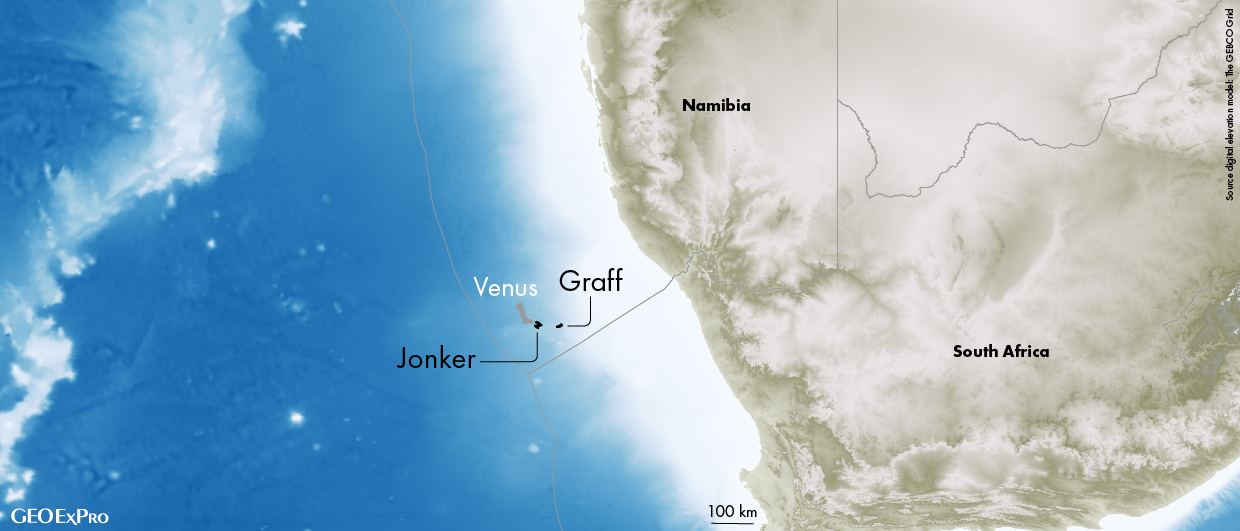StatoilHydro and Chesapeake Energy Corporation, the largest US natural gas producer, did in November enter a strategic agreement to jointly explore unconventional gas opportunities worldwide. Initially, StatoilHydro will acquire a 32.5% interest in Chesapeake’s Marcellus shale gas acreage covering 7,300 km2(slightly larger than a North Sea quadrant) in the Appalachian Basin of the northeastern USA. The agreement will cover leases in the states of Pennsylvania, West Virginia, New York and Ohio.
With this transaction StatoilHydro has acquired future, recoverable equity resources in the order of 2.5-3.0 billion barrels of oil equivalent (boe). StatoilHydro’s equity production from the Marcellus shale gas play is expected to increase to at least 50,000 boepd in 2012 and at least 200,000 boepd after 2020. In comparison, StatoilHydro’s current total equity production in 11 countries is approximately 1.9 MMboepd.
The Marcellus Shale
The Marcellus Shale, named after the town of Marcellus, New York, also referred to as the Marcellus Formation, is a Middle Devonian-age black, low density, organic rich shale that occurs in the subsurface beneath much of Ohio, West Virginia, Pennsylvania and New York. With its black colour it can easily be spotted in the field and its slightly radioactive signature makes it a very easy pick on a geophysical well log.
Throughout most of its extent, the Marcellus Shale is more than 1000m below the surface. These great depths make the Marcellus Formation a very expensive target. Successful wells must yield large volumes of gas to pay for the drilling costs that can easily exceed a million dollars for a traditional vertical well and much more for a horizontal well with hydraulic fracturing. In comparison, an exploration well in the North Sea often cost 20-30 million dollars while deep water wells in the Gulf of Mexico may cost 100 million dollars or more.
The gas in the Marcellus Shale is a result of its contained organic content. Logic therefore suggests that the more organic material there is contained in the rock the greater its ability to yield gas.
Natural gas occurs within the Marcellus Shale in three ways: 1) within the pore spaces of the shale; 2) within vertical fractures (joints) that break through the shale; and, 3) adsorbed on mineral grains and organic material. Most of the recoverable gas is contained in the pore spaces. However, the gas has difficulty escaping through the pore spaces because they are very tiny and poorly connected.
Most historic wells in the Marcellus produced gas at a very slow rate because of low permeability. However, some of the most successful historic wells in the Marcellus share a common characteristic: they intersect numerous fractures. These fractures allow the gas to flow through the rock unit and into the well bore. The fractures intersecting the well also intersect other fractures and those fractures intersect still more fractures. Thus, an extensive fracture network allows one well to drain gas from a very large volume of shale. A single well can recover gas from many acres of surrounding land.
Starting the play
 Fractured in Devonian-age shale. © geology.comSome years ago very few geologists were excited about the Marcellus Shale as a major source of natural gas. Wells drilled through it produced some gas but rarely in enormous quantity. Few if any in the natural gas industry suspected that the Marcellus might soon be a major contributor to the natural gas supply of the United States.
Fractured in Devonian-age shale. © geology.comSome years ago very few geologists were excited about the Marcellus Shale as a major source of natural gas. Wells drilled through it produced some gas but rarely in enormous quantity. Few if any in the natural gas industry suspected that the Marcellus might soon be a major contributor to the natural gas supply of the United States.
As recently as 2002, the United States Geological Survey in its Assessment of Undiscovered Oil and Gas Resources of the Appalachian Basin Province, calculated that the Marcellus Shale contained an estimated undiscovered resource of about 1.9 trillion cubic feet of gas (53MMm3oe or 342MMboe). That’s a lot of gas but spread over the enormous geographic extent of the Marcellus it was not that much per acre.
Range Resources started the Marcellus Shale gas play. In 2003 they drilled a Marcellus well in Washington County, Pennsylvania, and found a promising flow of natural gas. They experimented with drilling and hydraulic fracturing methods that worked in the Barnett Shale of Texas. Their first Marcellus gas production from the well began in 2005. Between then and the end of 2007 more than 375 gas wells with suspected Marcellus intent had been permitted in Pennsylvania. Range Resources now believe they have a 15-22 Tcf (420-616 MMm3oe; 2.7-.4 Bboe) potential in the play (October 2008 company presentation).
In early 2008, Terry Englander, a geoscience professor at Pennsylvania State University, and Gary Lash, a geology professor at the State University of New York at Fredonia, surprised everyone with estimates that the Marcellus might contain more than 500 trillion cubic feet of natural gas (14Bm3oe or 90Bboe). Using some of the same horizontal drilling and hydraulic fracturing methods that had previously been applied in the Barnett Shale of Texas, perhaps 10% of that gas (50 trillion cubic feet; 1,4BMm3oe or 9Bboe) might be recoverable. That volume of natural gas would be enough to supply the entire United States for about two years.
The need for horizontal wells
 Horizontal wells with hydraulic fractures are needed in order to establish productivity in shale gas reservoirs. In a hydraulic fracturing operation, water and sand under high pressure are injected into the formation in order to extract the gas from the reservoir. Illustration: StatoilHydroBefore 2000, many successful natural gas wells had been completed in the Marcellus. The yields of these wells were often unimpressive upon completion. However, many of these older wells in the Marcellus have a sustained production that decreases slowly over time. Many of them continued to produce gas for decades. A patient investor might make a profit from these low yield wells with slowly declining production rates.
Horizontal wells with hydraulic fractures are needed in order to establish productivity in shale gas reservoirs. In a hydraulic fracturing operation, water and sand under high pressure are injected into the formation in order to extract the gas from the reservoir. Illustration: StatoilHydroBefore 2000, many successful natural gas wells had been completed in the Marcellus. The yields of these wells were often unimpressive upon completion. However, many of these older wells in the Marcellus have a sustained production that decreases slowly over time. Many of them continued to produce gas for decades. A patient investor might make a profit from these low yield wells with slowly declining production rates.
For new wells drilled with the new horizontal drilling and hydraulic fracturing technologies the initial production can be much higher than what was seen in the old wells. Early production rates from some of the new wells have been over one million cubic feet of natural gas per day (180 boepd). The technology is so new that long term production data is not available. As with most gas wells, production rates will decline over time, however, a second hydraulic fracturing treatment could restimulate production.
The fractures in the Marcellus Shale are vertical. So, a vertical borehole would be expected to intersect very few of them. However, a horizontal well, drilled perpendicular to the most common fracture orientation should intersect a maximum number of fractures.
High yield wells in the Marcellus Shale have been built using the horizontal drilling technique. Some horizontal wells in the Marcellus Shale have initial flows that suggest that they are capable of yielding millions of cubic feet of gas per day, making them some of the most productive gas wells in the eastern United States. Although some experts are very optimistic on the long-term production rates of these wells, it is too early to determine their productive life or long-term yield.
Increase the number of fractures
A second method is used to increase the productivity of a well. That is to increase the number of fractures in a well using a technique known as “hydraulic fracturing” or “hydrofracing”. This method uses high-pressure water or a gel to induce fractures in the rock surrounding the well bore.
Hydrofracing is done by sealing off a portion of the well and injecting water or gel under very high pressure into the isolated portion of the hole. The high pressure fractures the rock and pushes the fractures open.
To prevent the fractures from closing when the pressure is reduced several tons of sand or other “propant” is pumped down the well and into the pressurized portion of the hole. When the fracturing occurs millions of sand grains are forced into the fractures. If enough sand grains are trapped in the fracture it will be propped partially open when the pressure is reduced. This provides an improved permeability for the flow of gas to the well.
Other gas shales in the US
The events described above are not unique to the northeastern United States or the Marcellus Shale. The horizontal drilling and hydrofracing technologies were perfected for shale reservoirs a few years ago in the Barnett Shale of Texas. The technology was then applied in other areas such as the Fayetteville Shale of northcentral Arkansas, the Haynesville Shale of northwestern Louisiana, and the Marcellus Shale in the Appalachians. These are just a few of several unconventional gas plays now happening in the United States and Canada. Similar organic shale deposits in other parts of the world might also produce gas as use of the new technologies spread.





